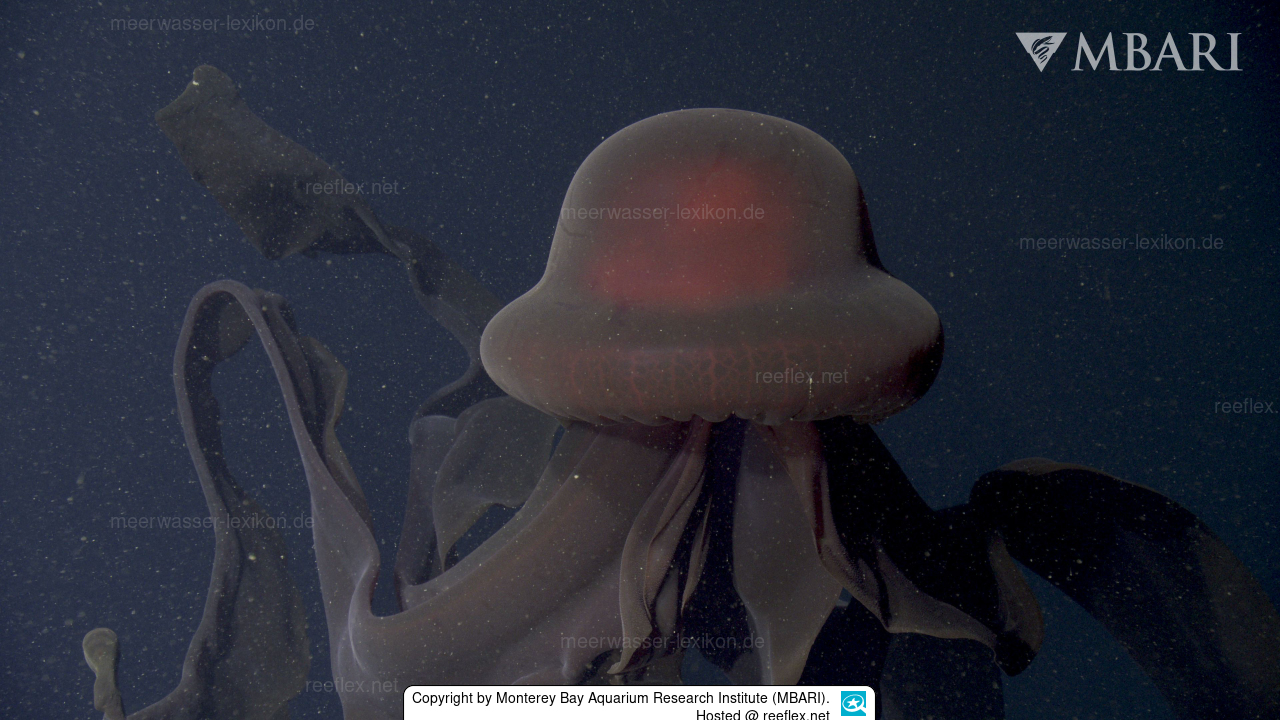Info
Note:
The size of 150cm given in the master data refers to the diameter of the bell / umbrella of the large jellyfish.
The ribbon-shaped mouth arms can reach a length of more than 10 meters!
The first specimen of the giant phantom jellyfish was collected in 1899, but it took scientists 60 years to recognize that it was a new species.
Even today, scientists still know very little about this animal.
The pictured specimen of Stygiomedusa gigantea was observed with the help of MBARI's remote-controlled vehicle (ROV) Doc Ricketts, first a billowing crimson curtain was noticed.
On closer inspection, the lights of the submersible reveal the giant phantom jellyfish.
Although classified as cosmopolitan according to SeaLifeBase, this spectacular species has actually only been observed nine times in thousands of dives with MBARI ROVs.
Quoting from MBARI:
“MBARI's observations of Stygiomedusa gigantea have helped to shed light on their ecological role in the depths of the ocean.
During an expedition in the Gulf of California, the MBARI ROV Tiburon recorded a fish – the pelagic breadula (Thalassobathia pelagica) – next to a giant phantom jellyfish.
The researchers observed the breadula hovering over the bell of its host and swimming in and out of the voluminous mouth arms of the jellyfish.
The vast waters of the midnight zone offer little protection, so many creatures find refuge in the gelatinous animals that are abundant in this environment.”
We would like to thank Susan von Thun, Science Communication and Content Manager, from the Monterey Bay Aquarium Research Institute for this great photo of the giant umbrella jellyfish.
Synonyms:
Diplulmaris gigantea Browne, 1910 · unaccepted (synonym)
Stygiomedusa fabulosa Russell, 1959 · unaccepted (synonym)
Stygiomedusa stauchi Repelin, 1967 · unaccepted (synonym)
The size of 150cm given in the master data refers to the diameter of the bell / umbrella of the large jellyfish.
The ribbon-shaped mouth arms can reach a length of more than 10 meters!
The first specimen of the giant phantom jellyfish was collected in 1899, but it took scientists 60 years to recognize that it was a new species.
Even today, scientists still know very little about this animal.
The pictured specimen of Stygiomedusa gigantea was observed with the help of MBARI's remote-controlled vehicle (ROV) Doc Ricketts, first a billowing crimson curtain was noticed.
On closer inspection, the lights of the submersible reveal the giant phantom jellyfish.
Although classified as cosmopolitan according to SeaLifeBase, this spectacular species has actually only been observed nine times in thousands of dives with MBARI ROVs.
Quoting from MBARI:
“MBARI's observations of Stygiomedusa gigantea have helped to shed light on their ecological role in the depths of the ocean.
During an expedition in the Gulf of California, the MBARI ROV Tiburon recorded a fish – the pelagic breadula (Thalassobathia pelagica) – next to a giant phantom jellyfish.
The researchers observed the breadula hovering over the bell of its host and swimming in and out of the voluminous mouth arms of the jellyfish.
The vast waters of the midnight zone offer little protection, so many creatures find refuge in the gelatinous animals that are abundant in this environment.”
We would like to thank Susan von Thun, Science Communication and Content Manager, from the Monterey Bay Aquarium Research Institute for this great photo of the giant umbrella jellyfish.
Synonyms:
Diplulmaris gigantea Browne, 1910 · unaccepted (synonym)
Stygiomedusa fabulosa Russell, 1959 · unaccepted (synonym)
Stygiomedusa stauchi Repelin, 1967 · unaccepted (synonym)







 Monterey Bay Aquarium Research Institute (MBARI), Kalifornien, USA
Monterey Bay Aquarium Research Institute (MBARI), Kalifornien, USA

